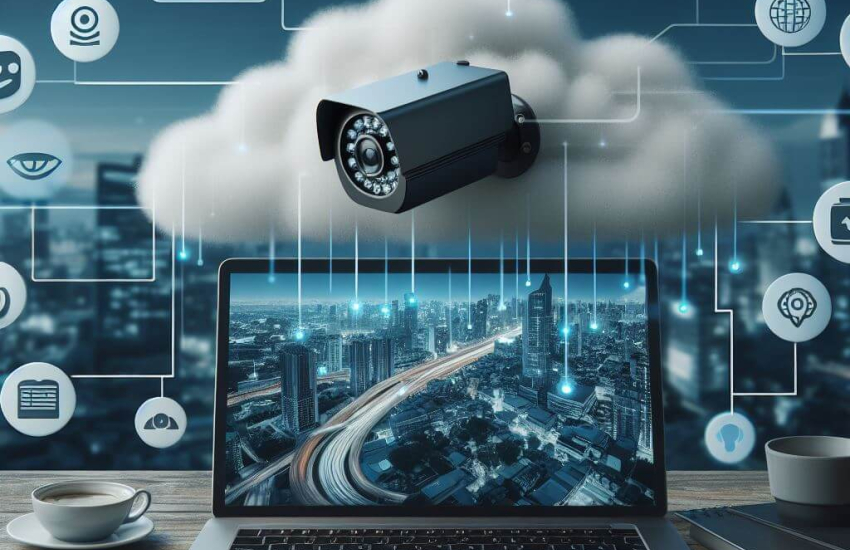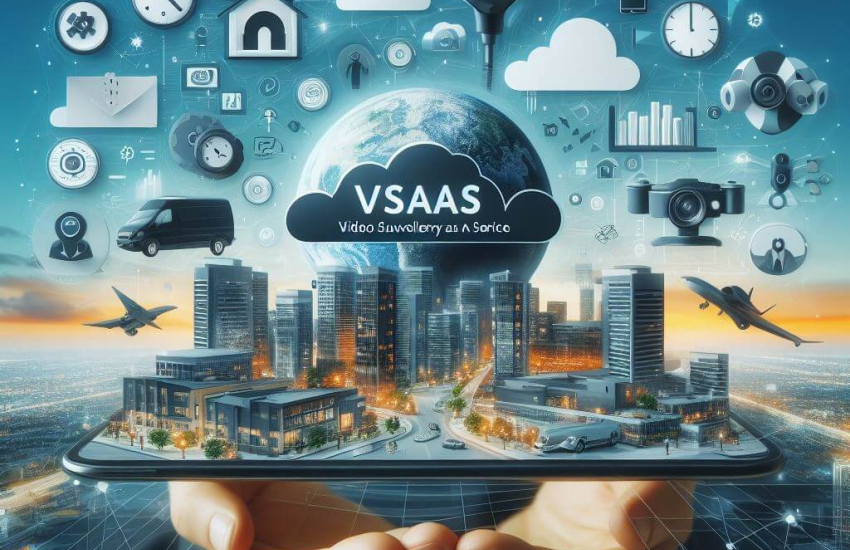What is VSaaS: How Video Surveillance as a Service is Revolutionizing the Security Landscape
You may remember when video surveillance meant setting up security cameras on the site with their bulky hardware and the monitoring room having to be within the premises. However, gone are those traditional days in the face of new challenges. And as they say, modern problems require modern solutions.
In order to fight new and unique emerging threats, people have started utilizing VSaaS. It helped significantly by reducing the cost of hardware and letting businesses have highly flexible surveillance management.
In this article, we will give you a quick rundown of VSaaS and how they are changing the world of surveillance.
The Evolution from Traditional Surveillance to Cloud-Based Solutions
From ancient spies and lookouts to the modern cloud-based surveillance system, we have come a very long distance. Not long ago, people used to think about many big monitoring cameras with many related devices to survey a place.
However, the issue with those traditional cameras and systems was that they had many drawbacks, including low-quality imaging, being costly, etc. Moreover, while those surveillance cameras could have done the job back then, they are failing to take up the threats of the current era.
It is easy to hack into those old devices, tamper with the data, and many more. One could also easily access the footage stored in the on-site storage, breaching the security. As such, the surveillance systems had to adapt. This need for something better gave birth to the VSaaS system.
Dissecting VSaaS Architecture

VSaaS means Video Surveillance as a Service. It implements a cloud-based monitoring system by connecting the imaging device to the network and directly streaming the video content to the cloud. So, anyone with access to the footage can observe it from a remote place.
As you can guess, the quality of VSaaS depends on the network connection, the cloud storage, and the relevant small devices required. Below, we have explained the different components of a VSaaS-
- Cameras (Or Other Monitoring Devices)
Unlike the traditional system, VSaaS doesn’t always only use cameras. It can utilize sensors, thermal cameras, and whatnot. You can use IP cameras with VSaaS to establish a high-quality surveillance system. The quality of pictures captured by these devices is way better than the CCTVs of the past.
As we mentioned, the internet connection significantly affects the quality of a VSaaS. In order to get proper and uninterrupted monitoring and streaming, there needs to be a high-speed network. People can use local area networks to keep internet use limited within certain premises.
- Cloud Storage
One of the best advantages VSaaS has over the traditional surveillance system is its cloud storage. Unlike on-site storage with costly hardware and maintenance, video files stored on the cloud will be safer. They are also easier to access and view. It also enables remote streaming.
- Video Analytics
Most modern VSaaS systems don’t just come as a monitoring surveillance system; they offer so many features that traditional security systems fail to do. For example, the motion detector, thermal sensor, face and voice recognition, and operation in very bright areas are possible with VSaaS.
- User Interface
The interface of a VSaaS is special and unique as it enables a person to easily control the monitoring system, observe the areas, download the relevant files and many other things from a long distance. One doesn’t even need any training or much experience to do any of these if they are somewhat familiar with modern technology.
As you can understand, the possibilities with VSaaS technology are endless. Not only does it provide versatile surveillance in the work environment, but it also allows the owners of the premises to alter the entire system as necessary with ease.
The Business Case for VSaaS

You may have already understood the benefits of integrating VSaaS within your business premises. But let’s still go over all the possible advantages that VSaaS can provide over the surveillance system of the old.
Flexibility
VSaaS doesn’t require an on-site server, storage unit, too much wiring, or any bulky hardware. So, the flexibility they bring is too much to overlook. You can’t install traditional surveillance in all places where VSaaS can be set up anywhere you want. If you want to change their positions, the process will be way easier, quicker, and cheaper.
Cost Efficiency
Since traditional surveillance systems require too much hardware and wiring, it is also costly to purchase all that. Moreover, their installation service charge also ends up being high. Meanwhile, not only are VSaaS system devices less costly to buy, but they are also easier and more efficient to set up.
Not to mention, their maintenance cost also tends to be way less in comparison.
Updates
VSaaS features advanced capabilities such as face recognition. As digital and electronic devices are operated by networks, they also get regular updates. So, you can expect them to be up-to-date without having to buy new devices to upgrade the system.
Security of Data
You can rest assured that no party will access the footage captured by the VMS cameras in your VSaaS system until you allow it. It is so because the data stays in the cloud instead of any on-site server.
Enhanced Security Features
As we mentioned, VSaaS has features like thermal sensors, face recognition, or motion detectors, something you couldn’t get from monitoring cameras in the past. They allow for higher security and can tackle greater threats. It is also easy to use the footage of VSaaS for evidence should the necessity arrive.
Video Analytics
The video analytics features of VSaaS allow you to keep track of various details within your business areas.
Crucial Factors in Selecting a VSaaS Provider
While VSaaS has all the fantastic features mentioned above, you shouldn’t neglect the importance of researching carefully before choosing a VSaaS provider. There are many factors to check to avoid picking one that isn’t up to your task or not worth the cost. They are as follows-
Open or Close
First things first, you must go for an open offering. It means that their cloud server will be accessible by multiple companies and products. If you are planning to integrate the VSaaS for your business, then an ‘open’ server will be the best for you, as other big-name companies like Google or Amazon do the same. But the’ close’ offering will be better if you aim to keep the surveillance system within personal and proprietary platforms.
Compliance
Your VSaaS provider should comply with what you and your business stand for. So, if you run a retail shop, they should offer the right service and offerings for that, such as recommending open cloud instead of closed.
Compatibility
If you already have spent on cameras or other necessary gadgets related to your VSaaS system, your provider shouldn’t make you buy new devices, which many do. Their device should be in accordance with your already owned ones. Otherwise, your previous expenses will be a colossal waste.
Reliability and Data Protection
Without question, you want a reliable provider when the topic at hand is the security of your business. While they are literally security providers, their own security may not often be as strong. It is something you should check. Ones with SOC 2, Type 2 compliance by the American Institute of CPAs (AICPA) are definitely more reliable than those without.
If your VSaaS provider is well-secured, their protection of your data is also more trustworthy.
Customer Service
Your VSaaS provider must be apparent and transparent to everything regarding their service. They should explain anything in detail when you ask, respond to any issues as soon as possible, and provide troubleshooting.
Integration and Compatibility
The compatibility of VSaaS allows them to fit right into the world of surveillance systems. In a VSaaS system, adding, replacing, or removing cameras is very straightforward. You can also make them work with various types of IP cameras.
VSaaS cameras are practical and future-proof. You won’t have to spend much on their installation, nor will you have to in the coming days. It feels like VSaaS was invented right for the modern IT ecosystem.
FAQs
What Makes a Good VSaaS Provider?
One that provides higher data security, reliability, cost-effective solutions, and as much storage as you need for your business is a good VSaaS provider for your cause.
What Are the Different Types of VSaaS?
There are two types of VSaaS right now-
- Managed VSaaS: The video data stays in the storage on the site, and the provider can manage it remotely.
- Hosted VSaaS: Also known as offsite recording, Hosted VSaaS is when the video files are sent to the provider’s data center on the client’s WAN. The provider can manage the content from there and keep it stored.
What Is the Difference Between SaaS & VSaaS?
SaaS means Software as a Service. It is when a business provides software to its clients as a service. VSaaS is similar, where the service in question is surveillance instead of any software.
Conclusion
With its cutting-edge technology, VSaaS is a game changer in the IT world, creating a more secure, faster, featureful, flexible, and cost-efficient service. Their components are not as complex as traditional surveillance means. If you want to install VSaaS on your premises, go for a reliable VSaaS provider.


